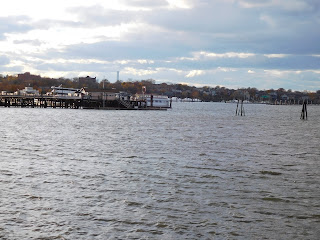Funny, how I can ride through an area I know well--or, at least I thought I knew well--and chance upon something I'd never seen before.
New York City's grid pattern seems utterly incongruous in places like Bayside, where North Shore coastline zigs and zags. (In fact, it seems incongruous that it is, even if only officially, part of New York City.) The nearest subway stop is about seven kilometers away; only a couple of bus lines along Bell and Northern Boulevards (the neighborhood's two main throughfares) and a Long Island Rail Road stop just off Northern connect this neighborhood with the rest of the city.
"Neighborhood" seems like a misnomer, as Bayside feels more like what would be described as a "leafy suburb". If you go there, you're not going for the night life; you are going there to raise your family or, as I did today, for a bike ride along the North Shore.
With its straight-arrow streets and its well-defined, well-ordered yards and other spaces, it's hard to believe that I've actually missed something on previous rides. But today, I turned down a street I'd never ridden before--Corbett Lane--and this caught my eye.
So now I know how the street got its name: James Corbett, the World Heavyweight Boxing Champion from 1892 until 1897. He won the title by knocking out the "unbeatable" John L. Sullivan and, many historians of the sport argue, changed prizefighting from mere brawling to an art form because of his scientific training and fighting techniques. He defeated Sullivan by wearing him down with feints and jabs before delivering the knockout blow. Muhammad Ali, among others, would win titles in the same way.
But he also changed boxing by simply making it more palatable to many who abhorred it. (Because it was so widely denounced, boxing was illegal in most states, which made it difficult to schedule bouts.) "Gentleman Jim" was a beloved figure both in and out of the ring because of his manners, clothing and movie-star looks. In fact, once his boxing career ended, he made more money from acting, on stage and films, than he ever did in the ring.
In a way, I'm not surprised that he lived in this house: It is attractive but not ostentatious, though I had to chuckle when I saw this in front:
Tosca, my Mercian fixie, somehow looks more appropriate. At least she doesn't flinch from a history lesson!
It was a short but sweet ride, if you'll indulge me a cliche, even if it looked as if I was riding straight into winter on my way home:
"Neighborhood" seems like a misnomer, as Bayside feels more like what would be described as a "leafy suburb". If you go there, you're not going for the night life; you are going there to raise your family or, as I did today, for a bike ride along the North Shore.
With its straight-arrow streets and its well-defined, well-ordered yards and other spaces, it's hard to believe that I've actually missed something on previous rides. But today, I turned down a street I'd never ridden before--Corbett Lane--and this caught my eye.
So now I know how the street got its name: James Corbett, the World Heavyweight Boxing Champion from 1892 until 1897. He won the title by knocking out the "unbeatable" John L. Sullivan and, many historians of the sport argue, changed prizefighting from mere brawling to an art form because of his scientific training and fighting techniques. He defeated Sullivan by wearing him down with feints and jabs before delivering the knockout blow. Muhammad Ali, among others, would win titles in the same way.
But he also changed boxing by simply making it more palatable to many who abhorred it. (Because it was so widely denounced, boxing was illegal in most states, which made it difficult to schedule bouts.) "Gentleman Jim" was a beloved figure both in and out of the ring because of his manners, clothing and movie-star looks. In fact, once his boxing career ended, he made more money from acting, on stage and films, than he ever did in the ring.
In a way, I'm not surprised that he lived in this house: It is attractive but not ostentatious, though I had to chuckle when I saw this in front:
Tosca, my Mercian fixie, somehow looks more appropriate. At least she doesn't flinch from a history lesson!
It was a short but sweet ride, if you'll indulge me a cliche, even if it looked as if I was riding straight into winter on my way home:









